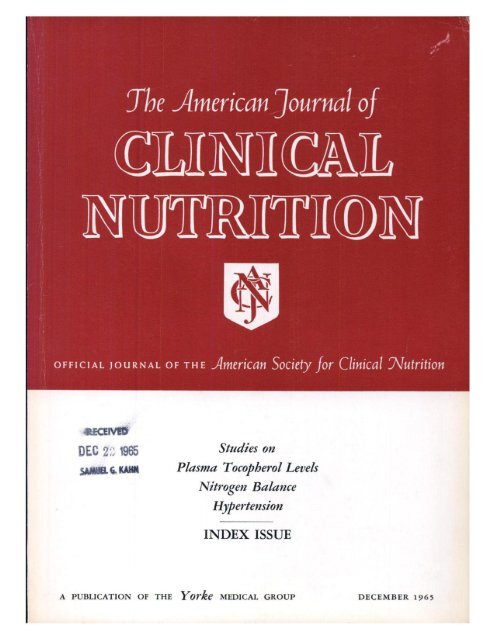方法对膳食补充剂暴露评估的影响:比较互动饮食和AARP队列研究中膳食补充剂的流行程度、产品类型和营养含量。
IF 6.5
1区 医学
Q1 NUTRITION & DIETETICS
引用次数: 0
摘要
背景:有效的膳食补充剂(DS)评估方法对营养研究和监测至关重要,因为DS对数百万美国人的微量营养素暴露有重大贡献。人们对膳食补充剂评估工具在估计膳食补充剂使用率和微量营养素含量方面的差异知之甚少:我们在美国退休人员饮食和活动追踪纵向研究(IDATA)中,比较了一年内重复收集的两种常用DS评估方法:饮食史问卷-II(DHQII)和自动自控24小时饮食回忆(ASA24):方法:在 IDATA 参与者(n=795;50-74 岁)中收集 DS 信息,这些参与者完成了 2-6 次 ASA24 和第二次 DHQII。在所有参与者中比较了个体水平的一致性(Kappa (κ))和群体水平的DS使用流行率(McNemar检验),并按产品类型进行了比较。在 DS 使用者中,比较了 DHQII 和 ASA24 中按来源分列的钙和维生素 D 平均摄入量,以及每天从 DS 中摄入的营养素量(即剂量)。钙和维生素 D 被选为重点营养素,因为它们反映了维生素和矿物质,而且在 DS 中无处不在:使用 DS 的流行率因产品类型而异(28 项比较中有 13 项在流行率上存在差异(McNemar 检验);Kappa 一致性范围:κ= -0.03 至 0.73))。根据 DHQII 和 ASA24 的评估,维生素 D(而非钙)的日平均消耗量存在显著差异(均值 ± SE):ASA24 的维生素 D 含量范围为 24±2.7 - 45±9.5 μg/d,而 DHQII 的维生素 D 含量范围为 12±0.3 - 14±0.3 μg/d(p 结论:在 IDATA 中,ASA24 和 DHQII 在估算 DS 的使用率和营养素摄入量方面的可比性因营养素和产品类型的不同而波动。在估算营养素绝对量时,可能需要采用问卷以外的 DS 方法,而 DS 评估方法的选择取决于所关注的营养素/膳食成分。本文章由计算机程序翻译,如有差异,请以英文原文为准。
Methods matter for dietary supplement exposure assessment: comparing prevalence, product types, and amounts of nutrients from dietary supplements in the Interactive Diet and Activity Tracking in the American Association of Retired Persons cohort study
Background
Valid dietary supplement (DS) assessment methods are critical for nutrition research and monitoring as DS contributes substantially toward micronutrient exposures for millions of Americans. Little is known about how DS assessment tools vary in estimating the prevalence of use and micronutrient amounts from DS.
Objectives
We compared repeat collections over a year of 2 commonly used DS assessment methods: the diet history questionnaire-II (DHQII) and the automated-self-administered 24-h dietary recall (ASA24), within the longitudinal Interactive Diet and Activity Tracking in American Association of Retired Persons (IDATA) study.
Methods
DS information was collected among IDATA participants (n = 795; 50–74 y) who completed 2–6 ASA24s and a second DHQII. Agreement [Kappa (κ)] at the individual level and group-level prevalence of DS use (McNemar’s test) overall and by product type were compared among all participants. Mean calcium and vitamin D intakes, by source, and nutrient amounts per consumption day (i.e., dosages) from DS were compared between the DHQII and ASA24 among DS users. Calcium and vitamin D were chosen as priority nutrients, as they reflect vitamins and minerals and are ubiquitous in DS.
Results
Prevalence of DS use varied by product type [13 of 28 comparisons differed in prevalence (McNemar’s test); Kappa agreement range: κ = –0.03 to 0.73)]. Mean consumption day amounts of vitamin D (but not calcium) were remarkably different as assessed by the DHQII and ASA24 (mean ± standard error): vitamin D ranged from 24 ± 2.7 to 45 ± 9.5 μg/d on the ASA24 and from 12 ± 0.3 to 14 ± 0.3 μg/d on the DHQII (P < 0.0001).
Conclusions
Within IDATA, the comparability of ASA24 and DHQII in estimating the prevalence of use of and nutrient intakes from DS fluctuates by nutrient and product type. DS approaches beyond a questionnaire may be warranted for estimating absolute nutrient amounts, and the choice of the DS assessment method depends on the nutrient/dietary component of interest.
求助全文
通过发布文献求助,成功后即可免费获取论文全文。
去求助
来源期刊
CiteScore
12.40
自引率
4.20%
发文量
332
审稿时长
38 days
期刊介绍:
American Journal of Clinical Nutrition is recognized as the most highly rated peer-reviewed, primary research journal in nutrition and dietetics.It focuses on publishing the latest research on various topics in nutrition, including but not limited to obesity, vitamins and minerals, nutrition and disease, and energy metabolism.
Purpose:
The purpose of AJCN is to:
Publish original research studies relevant to human and clinical nutrition.
Consider well-controlled clinical studies describing scientific mechanisms, efficacy, and safety of dietary interventions in the context of disease prevention or health benefits.
Encourage public health and epidemiologic studies relevant to human nutrition.
Promote innovative investigations of nutritional questions employing epigenetic, genomic, proteomic, and metabolomic approaches.
Include solicited editorials, book reviews, solicited or unsolicited review articles, invited controversy position papers, and letters to the Editor related to prior AJCN articles.
Peer Review Process:
All submitted material with scientific content undergoes peer review by the Editors or their designees before acceptance for publication.

 求助内容:
求助内容: 应助结果提醒方式:
应助结果提醒方式:


